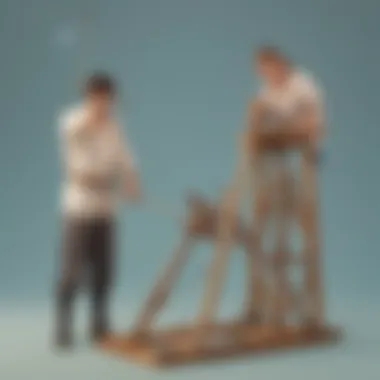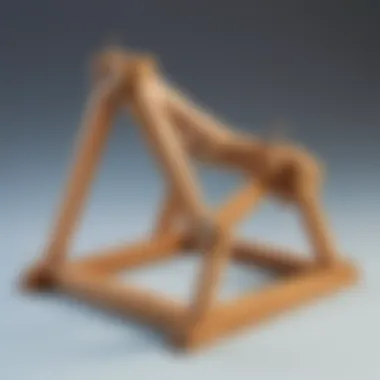Unveiling the Intricacies of Catapults: A Hands-On Experimentation Journey


Fun Facts and Trivia
Delve into captivating facts and intriguing trivia about the world of catapults! Uncover hidden gems of information that shed light on the historical, scientific, and cultural aspects of these remarkable siege engines.
- Evolution of Catapult Design: Explore how catapult designs evolved over centuries, from early torsion-powered machines to the sophisticated counterweight trebuchets. Discover the ingenuity of ancient engineers and how their creations paved the way for modern-day technologies.
- Catapult in Warfare: Learn about the strategic role of catapults in ancient and medieval warfare, where they were instrumental in siege battles and defensive operations. Understand the impact of catapults on military tactics and fortifications throughout history.
- Physics Behind Catapults: Delve into the physics principles that govern the operation of catapults, including potential and kinetic energy, projectile motion, and mechanical advantage. Gain a comprehensive understanding of the science that drives these formidable war machines.
- Catapult Innovations: Explore noteworthy innovations in catapult technology, such as the introduction of torsion springs and counterweight systems. Uncover the advancements that revolutionized catapult performance and effectiveness in various applications.
- Legendary Catapult Tales: Unearth myths and legends surrounding catapults in folklore and literature. Discover fantastical stories where catapults played pivotal roles, showcasing their enduring influence on culture and imagination.
Embark on a journey of discovery through fun facts and trivia that illuminate the fascinating world of catapults, enlightening and enriching your knowledge along the way.
Introduction to the Catapult Experiment
In this article, we delve into the captivating world of catapults, embarking on a journey through a series of experiments designed to illuminate the scientific principles that govern these ancient war machines. Catapults have played a pivotal role in history, from ancient battles to medieval sieges, showcasing their mechanical ingenuity and tactical significance. Through this exploration, we aim to provide a hands-on experience that unravels the intricate mechanics and operational dynamics of catapults, bridging the gap between theoretical knowledge and practical application.
Understanding the Concept of Catapults
Historical Significance:
Diving into the historical significance of catapults reveals a rich tapestry of innovation and strategic prowess. The evolution of catapult technology has shaped the course of warfare, from the innovative designs of the Greeks to the mechanical marvels of the Romans. Understanding the historical context is crucial for appreciating the engineering complexity and operational effectiveness of catapults, paving the way for a deeper exploration of their functionality in this article.
Basic Mechanics:
Exploring the basic mechanics of catapults uncovers the fundamental principles that drive these formidable machines. From tension and torsion to leverage and projectile projection, the intricate interplay of forces and mechanisms forms the backbone of catapult operation. By dissecting these core mechanics, we gain insight into the scientific principles that underpin catapult functionality, setting the stage for a detailed analysis of their operational nuances in the experiments ahead.
Types of Catapults:
Investigating the diverse types of catapults sheds light on the varying designs and capabilities that have emerged throughout history. From the iconic ballista to the imposing trebuchet, each catapult variation offers unique advantages and operational features. By exploring these different types, we cultivate a comprehensive understanding of the technological evolution and tactical versatility of catapults, laying a solid foundation for the experimentation and analysis to follow.
Purpose of the Experiment
Educational Objectives:
At the heart of this experiment lie educational objectives aimed at fostering a deeper appreciation for STEM disciplines through practical application. By engaging in hands-on experimentation with catapults, participants can grasp complex scientific concepts in a tangible and memorable way. This approach not only enhances theoretical knowledge but also cultivates critical thinking skills and problem-solving abilities, making learning a dynamic and immersive experience.
Hands-On Learning:
Hands-on learning serves as a cornerstone of this experiment, emphasizing the importance of tactile engagement and experiential discovery. By directly interacting with the catapult setup, participants can explore the intricacies of mechanics, trajectory, and force dynamics firsthand. This kinesthetic learning approach not only boosts retention and comprehension but also instills a sense of curiosity and creativity, fostering a lifelong passion for scientific exploration.
Overview of the Experimental Setup
Materials Required:


The materials required for this experiment span a range of components, from wooden frames and elastic bands to launching mechanisms and projectiles. Each material plays a crucial role in constructing and operating the catapult, enabling participants to witness firsthand the transformation of raw materials into a functional engineering marvel. By carefully selecting and assembling these materials, participants can unravel the secrets of catapult construction and operation, paving the way for insightful experimentation and analysis.
Assembly Instructions:
Navigating the assembly instructions is a critical aspect of preparing the catapult for experimentation. From meticulous step-by-step guidelines to intricate diagrams and measurements, the assembly process demands precision and attention to detail. Following these instructions not only ensures the successful construction of the catapult model but also imparts valuable insights into engineering processes and workflow management. By mastering the assembly instructions, participants can cultivate essential skills in project management and technical execution, setting the stage for a successful and informative experiment.
Safety Precautions
Safety Gear:
Prioritizing safety gear is paramount in ensuring a secure and risk-free experimental environment. From goggles and gloves to sturdy footwear and protective clothing, the right safety gear shields participants from potential hazards and minimizes the likelihood of accidents. By donning the appropriate safety gear, participants can engage in the experiment with peace of mind, focusing their attention on scientific exploration and data collection without compromising their well-being.
Supervision:
Supervision plays a crucial role in maintaining a safe and productive experimental setting. The presence of experienced supervisors not only provides guidance and assistance but also ensures compliance with safety protocols and operational guidelines. By having knowledgeable individuals overseeing the experiment, participants can address any uncertainties or challenges that may arise, fostering a collaborative and supportive learning environment conducive to exploration and discovery.
Conducting the Catapult Experiment
In the realm of experimentation, the section delving into the Conducting the Catapult Experiment holds paramount importance within the broader discourse of catapult exploration. Through meticulous steps and hands-on involvement, this segment embodies the very essence of practical scientific inquiry that catapults are inherently designed to elucidate. By engaging in the process of building, calibrating, testing, and analyzing data, participants are not only unraveling the nuances of catapult mechanics but also nurturing crucial skills of observation, measurement, and critical thinking. This section bridges the theoretical with the tangible, offering a gateway to comprehend the intricacies of projectile motion, forces at play, and the dynamic interaction between various components. Furthermore, the experiential learning derived from these activities fosters a deep-seated understanding of scientific principles, making the complex concepts accessible and relatable to aspiring young scientists and inquisitive minds.
Step 1: Building the Catapult Model
Gathering Materials
Embarking on the journey of constructing a catapult model necessitates a judicious selection of materials that marry functionality with structural integrity. The essence of gathering materials lies in procuring items that exhibit durability, flexibility, and lightweight attributes. The choice of materials profoundly influences the performance and longevity of the catapult design, accentuating the significance of selecting elements such as sturdy wood for the frame, resilient rubber bands for tension, and lightweight projectiles for optimal launch efficiency. These materials not only facilitate the construction process but also contribute to the overall robustness and effectiveness of the catapult model, enabling smoother functionality and enhanced durability. Amidst the plethora of material options available, prioritizing quality and compatibility ensures a seamless construction journey characterized by precision and resilience.
Constructing the Base
At the crux of catapult assembly lies the pivotal task of constructing a sturdy and stable base that forms the foundation of the entire structure. The intricacies of crafting the base entail meticulous attention to detail, precision in measurements, and adherence to the prescribed design schematics. The construction process necessitates a seamless fusion of structural elements, ensuring that the base is robust, balanced, and structurally sound to withstand the forces exerted during launches. Leveraging sturdy materials, strategic joint placements, and reinforcing reinforcements, the base emerges as the anchor holding the entire catapult model together. Its construction showcases a symphony of engineering principles and craftsmanship, culminating in a platform that embodies durability, functionality, and resilience.
Attaching the Launching Mechanism
Ascending to the culmination of catapult construction, the attachment of the launching mechanism heralds the final stages of model completion, infusing the apparatus with the crucial element of action. The process of attaching the launching mechanism entails a harmonious integration of moving parts, precise alignments, and meticulous calibration to ensure optimal performance. From affixing the tension-adjusting components to aligning the trajectory framework, every step demands accuracy and attention to detail. The launching mechanism serves as the heart of the catapult, dictating the propulsion, angle, and accuracy of projectile launches. Its meticulous attachment encapsulates the culmination of design considerations, functional optimization, and mechanical finesse, offering a seamless transition from static structure to dynamic functionality.
Step 2: Calibrating the Catapult
Adjusting Tension
At the crux of catapult functionality lies the intricate art of adjusting tension, a fundamental aspect that intricately balances power, accuracy, and launch efficiency. The process of tension adjustment involves delicately altering the elastic properties of the propulsion system, fine-tuning the force applied to the projectile upon release. By meticulously adjusting tension levels, participants can optimize the catapult's launching capabilities, fine-tuning the trajectory, and the velocity of projectiles. This calibration process requires a keen eye for precision, a steady hand for adjustments, and a thorough understanding of the interplay between tension and launch dynamics. The art of tension adjustment encapsulates the essence of catapult manipulation, offering a window into the intricate mechanics governing projectile propulsion and trajectory..
Aiming Mechanism


As the experiment progresses, the integration of an efficient aiming mechanism emerges as a pivotal aspect defining the catapult's accuracy and target precision. The design intricacies of the aiming mechanism encompass elements poised to align and direct the trajectory of projectiles with finesse and accuracy. By embedding precise sighting features, incline adjustments, and angular measurement tools, the aiming mechanism empowers participants to fine-tune launch angles for optimal distance and target acquisition. Skillfully navigating the complexities of the aiming mechanism demands a fusion of precision, calibration, and strategic manipulation to achieve pinpoint accuracy and consistent results. The element of aiming injects a strategic dimension to catapult experimentation, underscoring the synergy between mechanical design and operational precision.
Step 3: Conducting Test Launches
Measuring Distance
Venturing into the realm of empirical analysis, measuring distances emerges as a fundamental practice underpinning the evaluation of catapult performance and projectile dynamics. The process of measuring distance entails meticulous recording, precise instrumentation, and granular data collection to capture each launch's outcome accurately. By employing calibrated measuring tools, distance markers, and observation protocols, participants can quantify the effectiveness of projectile launches, assess flight trajectories, and extrapolate valuable insights into the operational capabilities of the catapult model. Measuring distance infuses a quantitative element into the experimental process, enabling participants to discern patterns, calculate velocities, and compare outcomes effectively, fostering a data-driven approach to catapult experimentation.
Analyzing Projectile Trajectory
Delving into the intricate nuances of projectile motion, the analysis of projectile trajectory underscores the importance of understanding the dynamic interplay between launch parameters and flight paths. The process of analyzing projectile trajectory delves into dissecting the curvature, height, and landing points of launched projectiles with precision and accuracy. By scrutinizing the trajectory patterns, flight durations, and impact points, participants gain valuable insights into the physics of projectile motion and the influence of external factors on launch dynamics. Analyzing projectile trajectory serves as a window into the intricacies of mechanical forces, aerodynamics, and launch kinetics, offering a comprehensive perspective on the interplay between design, execution, and empirical outcomes within the realm of catapult experimentation.
Step 4: Collecting Data and Observations
Record Keeping
Amidst the flurry of experimental activities, the practice of diligent record-keeping emerges as a cornerstone of robust data collection and analysis within catapult experimentation. The art of record-keeping entails methodical documentation, systematic data entry, and comprehensive log maintenance to track each launch's parameters and outcomes. By recording launch angles, distances, projectile types, and environmental conditions, participants lay the foundation for rigorous analysis, pattern identification, and results interpretation. The discipline of record-keeping fosters accountability, accuracy, and traceability, ensuring that experimental data remains organized, accessible, and conducive to in-depth analysis and longitudinal comparisons. Its integration underscores the scientific rigor and meticulous detail necessary for deriving meaningful conclusions and extrapolating actionable insights from catapult experimentation.
Identifying Patterns
Steering the trajectory of analysis towards pattern identification unveils a realm of data synthesis, correlation analysis, and trend recognition within catapult experimentation. The process of identifying patterns compels participants to discern recurring themes, anomalies, and correlations within the collected data, unveiling underlying tendencies and relationships. By scrutinizing launch outcomes, performance metrics, and environmental variables, participants can unravel hidden patterns, infer causal relationships, and construct predictive models to optimize catapult performance. The skill of pattern identification transcends mere observation, encapsulating the essence of analytical reasoning, hypothesis generation, and inference derivation within the empirical domain. Its application heralds a transformative shift from data points to actionable insights, fostering a holistic understanding of catapult functionality, performance dynamics, and operational nuances.
Analysis and Interpretation of Results
In the realm of the comprehensive experimentation regarding catapults, delving into the analysis and interpretation of results stands as a pivotal aspect of the empirical journey. This segment serves as the scholarly backbone, shedding light on the empirical outcomes derived from meticulous experimentation, offering insights that transcend mere observation.
Quantitative Analysis
Calculating Projectile Velocity
Diving into the intricacies of calculating projectile velocity within the context of catapult experimentation unveils a realm of mathematical precision and mechanical dynamics. The process of determining the velocity at which a projectile is projected plays a fundamental role in understanding the efficiency and effectiveness of a catapult mechanism. This quantitative analysis serves as a cornerstone in evaluating the performance and potential enhancements for catapult designs, aligning with the overarching objective of this research.
Determining Launch Angles
Exploring the significance of determining launch angles within the spectrum of catapult experiments unveils a crucial element in optimizing trajectory and distance coverage. The angle at which a projectile is launched significantly impacts its flight path and ultimate landing point, accentuating the importance of precision and calibration in catapult mechanics. By delving into the nuances of launch angles, researchers can fine-tune the performance of catapult models, enhancing both accuracy and efficiency within the scope of this study.
Qualitative Observations
Effects of Variables


Within the domain of qualitative analysis in catapult experimentation, scrutinizing the effects of variables emerges as a cornerstone in comprehending the nuanced interactions at play. Examining how different variables such as tension, projectile weight, and launch mechanisms impact the overall performance of a catapult provides invaluable insights into the intricacies of mechanical systems. By dissecting the effects of these variables, researchers can glean qualitative data to refine and optimize catapult functionality, elevating the experimental endeavors to a realm of meticulous precision.
Comparative Analysis
Embarking on a journey of comparative analysis in catapult research unveils a realm of insight into the relative efficacy of varying mechanisms and designs. Contrasting different catapult configurations and functionalities allows researchers to draw comparisons, highlighting the strengths and weaknesses of each paradigm. Through a detailed comparative analysis, this study aims to unearth the optimal approaches and design considerations that maximize catapult efficiency and performance, setting the stage for informed decision-making and subsequent improvements.
Discussion on Findings
Implications of Results
Unpacking the implications of results derived from catapult experiments offers a profound understanding of the broader implications and applications of this research endeavor. By discerning the implications of empirical outcomes, researchers can extrapolate valuable insights into real-world applications and theoretical advancements. This insightful analysis sheds light on the practical implications of catapult mechanics, paving the way for innovative solutions and scientific discoveries.
Potential Improvements
Delving into the realm of potential improvements within catapult experimentation underscores a commitment to continuous enhancement and optimization within the field of mechanical engineering. By scrutinizing the potential areas for refinement and innovation, researchers can chart a course towards elevated performance and functionality in catapult designs. This section aims to highlight the opportunities for improvement and future growth, catalyzing a culture of innovation and strategic advancement within the realm of catapult experimentation.
Conclusion and Future Applications
In the final section of this detailed exploration of catapults, we reflect on the profound impact and potential avenues for further study. Understanding catapult mechanics opens new realms of scientific inquiry and hands-on learning experiences. The practical implications of the experiment results are crucial in guiding future research and advancements in this field. By uncovering the intricate dynamics of catapults, individuals gain not only insights into historical warfare but also invaluable knowledge applicable to modern engineering concepts.
Key Takeaways
Understanding Catapult Mechanics
Delving into the nuances of catapult mechanics reveals the intricate interplay between tension, trajectory, and projectile force. This deep understanding enhances overall comprehension of physics principles and showcases the meticulous design considerations essential for optimal catapult performance. By grasping these intricate mechanics, individuals can appreciate the precision required in constructing and calibrating catapult models effectively. The resonating feature of understanding catapult mechanics lies in its ability to merge historical knowledge with practical engineering applications, making it a cornerstone element in catapult experimentation.
Hands-On Science Learning
Through hands-on science learning, participants engage in active exploration and experimentation, fostering a deeper connection with scientific concepts. This experiential approach not only cultivates critical thinking and problem-solving skills but also stimulates curiosity and innovation. Hands-on science learning proves to be a pivotal component in this article, offering a dynamic and immersive experience that transcends theoretical knowledge. Embracing this practical aspect enriches the educational journey by bridging theoretical concepts with real-world applications, establishing a solid foundation for future exploration in science and engineering.
Implications for Further Research
Advanced Catapult Designs
The evolution of catapult designs presents a continuous avenue for enhancements and innovations. Exploring advanced catapult designs delves into cutting-edge technology, materials, and mechanisms that push the boundaries of traditional catapult structures. By focusing on streamlined efficiency, accuracy, and scalability, advanced designs open new possibilities for catapult applications in various fields. The key characteristic of advanced catapult designs lies in their ability to revolutionize projectile launch mechanisms, optimizing performance while minimizing friction and mechanical strain. Integrating advanced designs into catapult experimentation expands the horizons of scientific exploration and engineering ingenuity.
Real-World Applications
Translating catapult mechanisms into real-world applications unveils a wealth of possibilities across multiple industries. The practical significance of catapult technology extends beyond historical recreations to modern-day uses in fields such as aerospace, defense, and sports. By studying real-world applications, researchers can adapt catapult principles to address contemporary challenges, enhance efficiency, and drive innovation. The unique feature of exploring real-world applications lies in its capacity to bridge the gap between theoretical knowledge and practical implementation, fostering a symbiotic relationship between scientific theory and technological advancement.
Closing Remarks
Encouraging Scientific Curiosity
Exploring Engineering Concepts
Exploring engineering concepts alongside catapult experimentation offers a multifaceted approach that intertwines creativity with scientific rigor. By exploring engineering principles, participants gain insights into structural integrity, material science, and design optimization. This comprehensive exploration equips individuals with the skills to tackle complex engineering challenges with confidence and ingenuity. The unique feature of exploring engineering concepts within this article lies in its capacity to blend theoretical knowledge with practical application, instilling a holistic understanding of engineering principles in the context of catapult mechanics.



